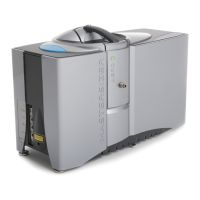Sample preparation guidance Chapter 6
Mastersizer 3000 Page 6-7
Surfactants and admixtures
If experiencing problems such as the sample floating on the surface of the disper-
sant, addition of a surfactant or admixture may help.
Surfactants
Adding a surfactant may help in preparation of the sample it will lower the surface
tension, which promotes wetting of the particles.
Surfactants have to be added in minute quantities, typically one drop per litre of
dispersant. If too much surfactant is added the action of stirring and pumping the
sample may cause it to froth, causing bubbles to be introduced into the system.
Bubbles are seen by the system as particles which can bias the measurement. Anti-
foaming agents may be added to prevent the formation of bubbles but, owing to the
fact that these may contain particulates, they should be added to the dispersant
before the background is measured.
Try adding a drop of surfactant to a quantity of sample and dispersant mixed in a
small beaker. If the sample sinks to the bottom of the beaker in large clumps, dis-
pose of the sample and start again. This time add the sample to a dry beaker, add a
drop of surfactant and mix thoroughly to a thick paste. Add the dispersant and mix
well. This usually avoids the agglomeration caused by adding the dispersant first.
A list of recommended surfactants in order of common use is given below:
Admixtures
Admixtures work by causing the particle surface to become charged, causing parti-
cles to repel each other (i.e. providing a zeta-potential to aid dispersion). Admix-
tures are added in larger quantities, typically 1g/l. A list of commonly used
admixtures is given below:
Sodium Hexametaphosphate (e.g. Calgon)
Sodium Pyrophosphate
Trisodium Phosphate
Ammonia
Surfactant Nature
Igepal Non-ionic
Teepol L Non-ionic
Synperonic N Non-ionic
Aerosol OT Anionic (solid)
Sodium dodecyl sulphate Anionic
Hyamine 2389 Cationic

